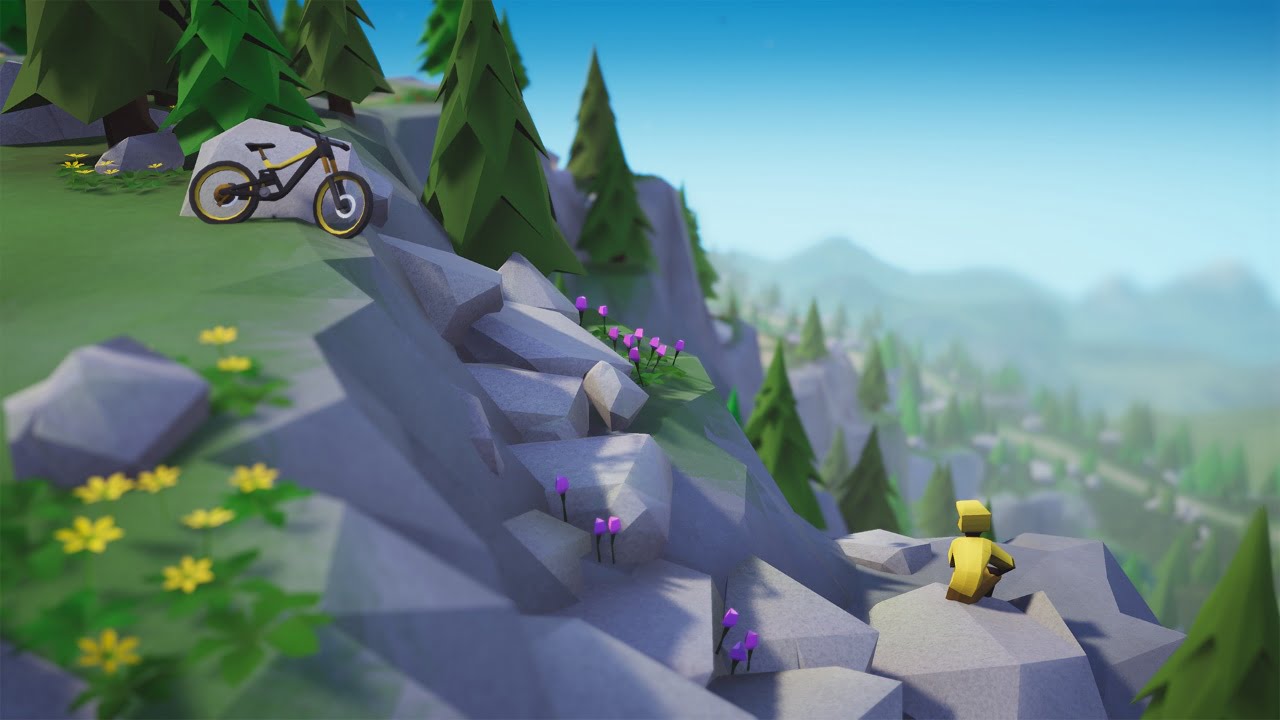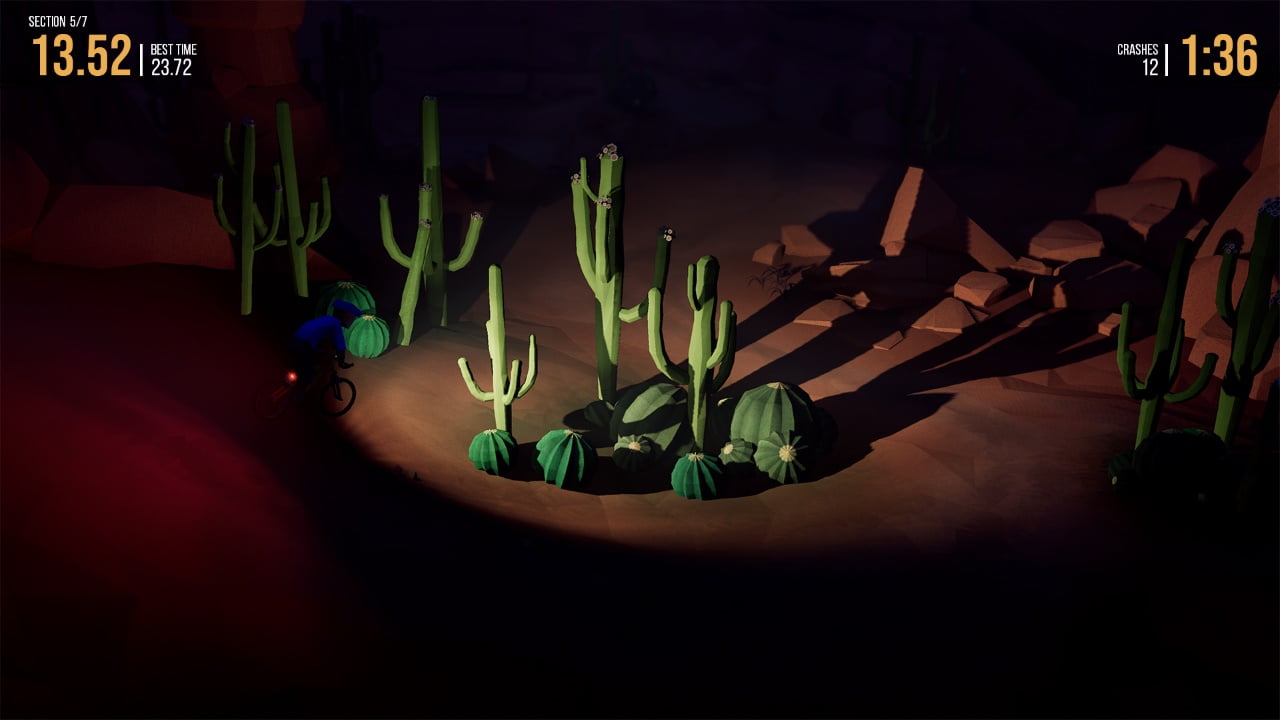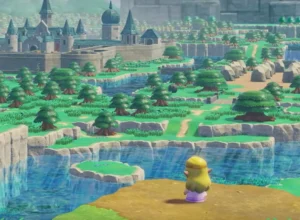Lonely Mountains: Downhill rides onto the Nintendo Switch. It’s time to pump up those tyres and hit the wilderness once more.
It’s not something we often talk about, but there’s a crispness and clarity to Lonely Mountains: Downhill. That’s not to say those words aren’t in the collective video game vocabulary, but they’re rarely used in good faith.
When people talk about crispness, or clarity, they’re almost always referring to visual fidelity. They’re talking about resolution and frame rates and antialiasing. Remember those boring old uncles at parties, who would talk incessantly about cars, or their favourite sports team, or hi-fi separates? Those drips, those human joy sponges, are the sorts of people who think a game is better because it runs a higher frame rate.
It’s time to reclaim those terms. Forget technical jargon and tedious Top Trumps; let’s use them instead to talk about something more meaningful, like crispness of vision or clarity of intent. Let’s use them to talk about something wonderful, like Lonely Mountains: Downhill.
Lonely Mountains: Downhill finds you at the top of a mountain, as all good mountain bike adventures should, with knobbly tyres beneath and a crash helmet above. There are thin margins between you and failure, as in real life. And fail you will. A lot. At times you’ll rattle down the mountainside like a ball in a Pachinko machine, hitting every tree and rock and stump, careening off every edge and into every pond.

You might even struggle with the controls. The game, by default, starts up with an eight-directional scheme that, try as I might, I could not fathom. Others have told me they don’t understand why, but it just intuitively works. However, the tattered gears and linkages in my primate brain could not make the correct decision at any point. Then I switched to classic Micro Machines controls – where the cyclist pivots clockwise or counter-clockwise based on the direction the nose of the bike is pointing – and it all clicked into place.
The important thing is that Lonely Mountains: Downhill isn’t unnecessarily punitive – instant reloads are critical in a game with fine margins and knife-edge failure – and, as with the controls, there are always options.
The titular mountains, lonely as they are, are split into numerous downhill trails. First, you’ll be given a free ride down, with no time pressures and no objectives. Then, once you’ve crossed all the checkpoints and reached the bottom – and you’ve had a good look at the trail – it’s time to start the challenges. Time-attacks are standard, obviously, with targets growing tighter as you improve. You can best the novice targets by sticking to the established trails, but in order to achieve the best times? You’ll need to venture off the beaten path.
Sometimes that means just clipping a corner, kissing the apex, or cutting it off altogether. That will shave off a few milliseconds from your split times. But if you chart your own route, barrelling down sheer gravel chutes or hopping down rock faces or leaping across chasms, then you can cut out huge swathes of the course. Your times will tumble as a result, which will access new challenges, bikes, and customisation options. But greater reward brings greater risk, and as your times tumble, your rider will, too.
But you’re not always in the mood for breakneck recklessness and hundreds of retries. Sometimes you want to explore without the time pressure. That’s catered for, too, with as much enjoyment to be found just in bumbling about the mountain as racing for time. The game even features hidden rest spots, beautiful dioramas where you can park your bike, park yourself, and just drink in the game’s sumptuous atmosphere.

There’s no music in Lonely Mountains: Downhill, either. The only sounds are the chirrups of birdsong and the crunch of knobbly tyres on dirt, gravel, and rock. And that’s as it should be. You can enjoy the silence, or you can pop in some earbuds and listen to your own soundtrack. It harkens back to my youth, skipping through the forest with grunge and punk rock on mixtape cassettes, as the new kid on the block, the Sony Discman, was too prone to skipping to be taken on such an adventure.
There’s a zenlike aspect to Lonely Mountains: Downhill that, once you’ve found it, amongst the wilderness, it grabs you. It’s remarkable clarity of design for what appears, on the face of it, as a knockabout arcade racer.
With that in mind, Lonely Mountains: Downhill also features challenges based on arriving at the bottom (relatively) safely. New trails and mountains are gated behind getting to the bottom with less than a specified number of crashes. There’s even a permadeath-like mode with no checkpoints and no restarts, and if you beat that? You can unlock the option to take on the trails at night.
And here’s the thing: there are no lighting sources, other than the pathetic white bulb on your bike’s handlebars. Nobody’s lined the trail with Tiki torches or strings of fairy lights or strategically-placed floodlights. There’s no dubious ambient glow or convenient skybox gradient. It is dark, it is stark, and it is a brilliant piece of design.

If you’re going to succeed on Lonely Mountains: Downhill – and even more so, the night stages – you’ll need to learn the trails, their personalities and their pitfalls. In the age of procedural generation, it’s a beautiful slice of praxis to have to learn intricately-designed courses once more, to experiment, to improve, to better your own abilities and by extension, improve your times.
But exploring these handcrafted mountain dioramas is its own joy because they are just so sumptuous. It might seem simplistic at a glance, but the low poly visuals are teeming with life and are anything but low fidelity. Each stage, each scene, is carefully assembled and layered, dripping in sun shafts and particle effects and depth of field, all built with optimal viewpoints in mind.
Rather than an over-the-shoulder or orbital camera that we’re so familiar with in extreme sports games, the viewpoint on Lonely Mountains: Downhill tracks down the trail on a pre-defined path. This means you’ll be treated to the sort of perfect cinematography that you’ll never achieve with either procedural generation or user-controlled cameras. Sure, you might stumble on something beautiful every now and then if you’re in charge, but there’s a reason why open-world games wrestle control of the camera away from the player if they want to show off their most beautiful vista or their sparkliest sunset. It wants you to see the game at its most vibrant, to make sure all that time and energy setting up those moments wasn’t wasted.
Lonely Mountains: Downhill is crammed full of those moments of elegant crispness, to the exclusion of most anything else. It’s almost exhausting how postcard-pretty the game is, but don’t worry: you’ll crash into a tree or a rock before too long, and come back down to earth with an unceremonious thump.
That’s the joy of downhill mountain biking, captured in capsule form, and it’s even better now you can take it out on the trail on Nintendo Switch.
(Well, when lockdown lifts and you’re allowed outside once more. Until then, Lonely Mountains: Downhill brings a welcome slice of the outside inside.)
Platform: Nintendo Switch (Reviewed), PC, PS4, Xbox One, Linux, Mac
Developer: Megagon Industries
Publisher: Thunderful Group
Release Date: May 7, 2020






